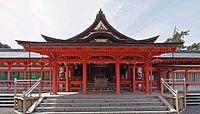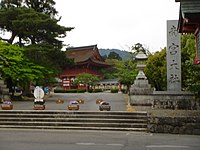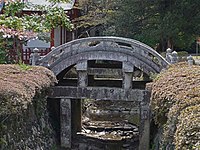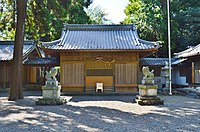Nangū Taisha

Nangū Taisha (南宮大社) is a Shinto shrine located in the town of Tarui in Fuwa District, Gifu Prefecture, Japan. It is the ichinomiya of former Mino Province. The main festival of the shrine is held annually on May 25.[1] The shrine precincts contain 18 structures from the Edo period, which are designated national Important Cultural Properties. The main building of the shrine is rebuilt every 51 years.
Enshrined kami
The kami enshrined at Nangū Taisha is:
- Kanayama-hiko-no-mikoto (金山彦命), the kami of mining and the metals industry.
History
Nangū Taisha is located in the southwestern corner of Gifu Prefecture, at the foot of Mount Nangū. The name "Nangū" derives from its location to the south of the ancient Mino Provincial Capital. Nangū Taisha claims to have been first built during the reign of the legendary Emperor Sujin (97 BC – 30 BC), although there are no historical records prior to its mention in the 836 Shoku Nihon Kōki and in the 859 Nihon Sandai Jitsuroku. The mid-Heian period Engishiki confirmed its status as a myōjin taisha (名神大社). The shrine was destroyed by a fire in 1501, which destroyed all its records. It was rebuilt by Toki Masafusa, the shugo of Mino Province in 1511.[2]
During the nearby Battle of Sekigahara in 1600, the shrine was again completely burnt to the ground and was not rebuilt until 1642, when Shogun Tokugawa Iemitsu sponsored the construction efforts.[3] The shrine retains a document which details the cost of the reconstruction. In 1867, as a result of shinbutsu bunri, the Buddhist temple located on the shrine grounds was moved to a different location and named Shinzen-in (真禅院). In 1871, the shrine was designated as a National shrine, 2nd rank (国幣中社, Kokuhei Chūsha) under the Modern system of ranked Shinto shrines of State Shinto. It was promoted to a National shrine, 1st rank (国幣大社, Kokuhei Taisha) in 1925, and its name was changed from "Jinja" to "Taisha" to reflect its more important status.[2]
The shrine is located approximately one kilometer southwest of Tarui Station on the JR Tokai Tōkaidō Main Line.[4]
Nangū Otabi Shrine
Nangū Otabi Shrine (南宮御旅神社, Nangū Otabi Jinja) is the Soja Shrine of Mino Province. It enshrines all fhe deities of the province
Whenever a new kokushi was appointed by the central government to govern a province, it was necessary for him to visit all of the sanctuaries of his province in order to complete the rites necessary for ceremonial inauguration. Grouping the kami into one location near the capital of the province greatly facilitated this duty,[5]
Gallery
-
 Haiden (ICP)
Haiden (ICP) - Kobu-den (ICP)
- Rōmon (ICP)
- Stone Torii (ICP)
-
 Entry
Entry - Great Torii
-
 Ring Bridge (ICP)
Ring Bridge (ICP) - Sub-shrine Juge Shrine & Sub-shrine Takayama Shrine (ICPs)
- Sub-shrine Takayama Shrine (ICP)
-
 Soja shrine Nangu Otabi Shrine
Soja shrine Nangu Otabi Shrine
Cultural Properties
Important Cultural Properties
- Honden (Main shrine), built in 1642. [6]
- Heiden, built in 1642.[7]
- Haiden, built in 1642.[8]
- Cloister, built in 1642. [9][10]
- Chokushi-den, built in 1642.[11]
- Kobu-den, built in 1642.[12]
- Rōmon (楼門), built in 1642.[13]
- Mikoshi Garage (楼門), built in 1642.[14]
- Shinkanro (神官廊), built in 1642.[15]
- Sub-shrine Juge Jinja Honden[16]
- Sub-shrine Takayama Jinja Honden[17]
- Sub-shrine Hayato Jinja Honden [18]
- Sub-shrine Nandai Jinja Honden[19]
- Sub-shrine Shichi-ōji Jinja Honden [20]
- Stone Torii, built in 1642 and located in Tarui-juku, built in 1642.[21]
- Ring Bridge (輪橋, Rinkyō), built in 1642.[22]
- Gekō Bridge (下向橋, Gekōkyō), built in 1642.[23]
- Tachi, signed Yasumitsu, donated by Toki Yoriyoshi in 1398[24]
- Tachi, Heian period, signed by Munechika Sanjo[25]
- Halberd (2 pcs), Nara period[26]
- Historical documents of Nangū Taisha (623 volumes)
See also
Notes
- ^ Shibuya, Nobuhiro (2015). Shokoku jinja Ichinomiya Ninomiya San'nomiya (in Japanese). Yamakawa shuppansha. ISBN 978-4634150867.
- ^ a b Yoshiki, Emi (2007). Zenkoku 'Ichinomiya' tettei gaido (in Japanese). PHP Institute. ISBN 978-4569669304.
- ^ Nangū Taisha Archived 2009-02-08 at the Wayback Machine. Zenkoku Kaiun Jinja Bukkaku Guide. Accessed May 9, 2009.
- ^ Okada, Shoji (2014). Taiyō no chizuchō 24 zenkoku 'Ichinomiya' meguri (in Japanese). Heibonsha. ISBN 978-4582945614.
- ^ Bocking, Brian (2016). A Popular Dictionary of Shinto. Routledge. ISBN 978-1138979079.
- ^ "南宮神社 本殿" [Nangū Taisha Honden] (in Japanese). Agency for Cultural Affairs. Retrieved August 20, 2020.
- ^ "南宮神社 幣殿" [Nangū Taisha Heiden] (in Japanese). Agency for Cultural Affairs. Retrieved August 20, 2020.
- ^ "南宮神社 拝殿" [Nangū Taisha Haiden] (in Japanese). Agency for Cultural Affairs. Retrieved August 20, 2020.
- ^ "南宮神社 回廊" [Nangū Taisha Kairō] (in Japanese). Agency for Cultural Affairs. Retrieved August 20, 2020.
- ^ "南宮神社 回廊" [Nangū Taisha Kairō] (in Japanese). Agency for Cultural Affairs. Retrieved August 20, 2020.
- ^ "南宮神社 勅使殿" [Nangū Taisha Chokushi-den] (in Japanese). Agency for Cultural Affairs. Retrieved August 20, 2020.
- ^ "南宮神社 高舞殿" [Nangū Taisha Kobuden] (in Japanese). Agency for Cultural Affairs. Retrieved August 20, 2020.
- ^ "南宮神社 楼門" [Nangū Taisha Rōmon] (in Japanese). Agency for Cultural Affairs. Retrieved August 20, 2020.
- ^ "南宮神社 神輿舎" [Nangū Taisha Shinyosha] (in Japanese). Agency for Cultural Affairs. Retrieved August 20, 2020.
- ^ "南宮神社 神官廊" [Nangū Taisha Shinkanro] (in Japanese). Agency for Cultural Affairs. Retrieved August 20, 2020.
- ^ "南宮神社 摂社樹下神社本殿" [Nangū Taisha Sessha Juge Jinja Honden] (in Japanese). Agency for Cultural Affairs. Retrieved August 20, 2020.
- ^ "南宮神社 摂社高山神社本殿" [Nangū Taisha Sessha Takayama Jinja Honden] (in Japanese). Agency for Cultural Affairs. Retrieved August 20, 2020.
- ^ "南宮神社 摂社隼人神社本殿" [Nangū Taisha Sessha Hayato Jinja Honden] (in Japanese). Agency for Cultural Affairs. Retrieved August 20, 2020.
- ^ "南宮神社 摂社南大神神社本殿" [Nangū Taisha Sessha Sandai Jinja Honden] (in Japanese). Agency for Cultural Affairs. Retrieved August 20, 2020.
- ^ "南宮神社 摂社七王子神社本殿" [Nangū Taisha Sessha Sandai Jinja Honden] (in Japanese). Agency for Cultural Affairs. Retrieved August 20, 2020.
- ^ "南宮神社 鳥居" [Nangū Taisha Torii] (in Japanese). Agency for Cultural Affairs. Retrieved August 20, 2020.
- ^ "南宮神社 輪橋" [Nangū Taisha Rinkyō] (in Japanese). Agency for Cultural Affairs. Retrieved August 20, 2020.
- ^ "南宮神社 下向橋" [Nangū Taisha Gekōkyō] (in Japanese). Agency for Cultural Affairs. Retrieved August 20, 2020.
- ^ "太刀〈銘康光/〉" [Tachi] (in Japanese). Agency for Cultural Affairs. Retrieved August 20, 2020.
- ^ "太刀〈銘三条/〉" [Tachi] (in Japanese). Agency for Cultural Affairs. Retrieved August 20, 2020.
- ^ "鉾〈無銘/〉" [Tachi] (in Japanese). Agency for Cultural Affairs. Retrieved August 20, 2020.
External links

- Official home page
- v
- t
- e
| |||||||||
Others | |||||||||||||||||||||||||
|---|---|---|---|---|---|---|---|---|---|---|---|---|---|---|---|---|---|---|---|---|---|---|---|---|---|
| |||||||||||||||||||||||||




















